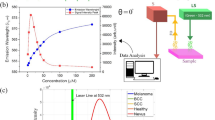Abstract
This investigation is based on images obtained from healthy tissue and skin cancer lesions and their fluorescent spectra of cutaneous lesions derived after optical stimulation. Our analyses show that the lesions’ spectra of are different of those, obtained from normal tissue and the differences depend on the type of cancer. We use a comparison between these “healthy” and “unhealthy” spectra to define forms of variations and corresponding diseases. However, the value of the emitted light varies not only between the patients, but also depending on the position of the tested area inside of one lesion. These variations could be result from two reasons: different degree of damaging and different thickness of the suspicious lesion area. Regarded to the visible image of the lesion, it could be connected with the chroma of colour of the tested area and the lesion homogeneity that corresponds to particular disease. For our investigation, images and spectra of three non-melanoma cutanous malignant tumors are investigated, namely—basal cell carcinoma, squamous cell carcinoma, and keratoacanthoma. The images were processed obtaining the chroma by elimination of the background—healthy tissue, and applying it as a basic signal for transformation from RGB to Lab colorimetric model. The chroma of the areas of emission is compared with the relative value of fluorescence spectra. Specific spectral features are used to develop hybrid diagnostic algorithm (including image and spectral features) for differentiation of these three kinds of malignant cutaneous pathologies.
Similar content being viewed by others
References
J. Lademann, A. Patzelt, M. Worm, H. Richter, W. Sterry, and M. Meinke, “Analysis of in vivo Penetration of Textile Dyes Causing Allergic Reactions,” Laser Phys. Lett. 6, 759–763 (2009).
D. Chorvat, Jr. and A. Chorvatova, “Multi-wavelength Fluorescence Lifetime Spectroscopy: A New Approach to the Study of Endogenous Fluorescence in Living Cells and Tissues,” Laser Phys. Lett. 6, 175–193 (2009).
I. M. Vlasova and A. M. Saletsky, “Raman Spectros- copy in Comparative Investigations of Mechanisms of Binding of Three Molecular Probes—Fluorescein, Eosin, and Erythrosin—to Human Serum Albumin,” Laser Phys. Lett. A 5, 834–839 (2008).
M. Vaishakh, V. M. Murukeshan, and L. K. Sean, “An Image Fiber Based Fluorescent Probe with Associated Signal Processing Scheme for Biomedical Diagnostics,” Laser Phys. Lett. 5, 760–763 (2008).
Lemelle, B. Veksler, I. S. Kozhevnikov, G. G. Akchurin, S. A. Piletsky, and I. Meglinski, “Application of Gold Nanoparticles as Contrast AGents in Confocal Laser Scanning Microscopy,” Laser Phys. Lett. 6, 71–75 (2009).
J. Lademann, A. Patzelt, M. Darvin, H. Richter, C. Antoniou, W. Sterry, and S. Koch, “Application of Optical Non-invasive Methods in Skin Physiology,” Laser Phys. Lett. 5, 335–346 (2008).
I. M. Vlasova and A. M. Saletsky, “Raman Spectroscopy in Investigations of Mechanism of Binding of Human Serum Albumin to Molecular Probe Fluorescein,” Laser Phys. Lett. 5, 384–389 (2008).
E. E. Scheller, E. Rohde, O. Minet, G. Muller, and U. Bindig, “Calculations Regarding Cell Metabolism Stimulation Using Photons in the Visible Wavelength Range,” Laser Phys. Lett. 5, 70–74 (2008).
E. Borisova, P. Troyanova, P. Pavlova, and L. Avramov, “Pigmented Skin Tumors Diagnosis Based on Laser-induced Autofluorescence and Diffuse Reflectance Spectroscopy,” Quantum Electron. 38, 597–605 (2008).
CIE, Colorimetry, 2nd ed., Publication CIE No.15.2 (Central Bureau of the CIE, Vienna, Austria, 1986).
D. Pascale, RGB coordinates of the Macbeth ColorChecker (2006), http://www.bablelcolor.com/down-load/
P. Pavlova, E. Borisova, and L. Avramov, “Automation of the Skin Cancer Diagnostics on the Bases of Reflectance Spectroscopy,” in Proc. of the 9th Intern. Conf. on Biomedical Physics and Engineering (Sofia, 2004), pp. 260–265.
Chromatic Monitoring of Complex Conditions, Ed. by G. Jones, A. Deakin, and J. Spenser (Taylor Francis (CRC Press), 2008), ISBN 9781584889885.
Author information
Authors and Affiliations
Corresponding author
Additional information
Original Russian Text © Astro, Ltd., 2010.
The article is published in the original.
Rights and permissions
About this article
Cite this article
Pavlova, P., Borisova, E., Avramov, L. et al. Investigation of relations between skin cancer lesions’ images and their fluorescent spectra. Laser Phys. 20, 596–603 (2010). https://doi.org/10.1134/S1054660X10050142
Received:
Accepted:
Published:
Issue Date:
DOI: https://doi.org/10.1134/S1054660X10050142




